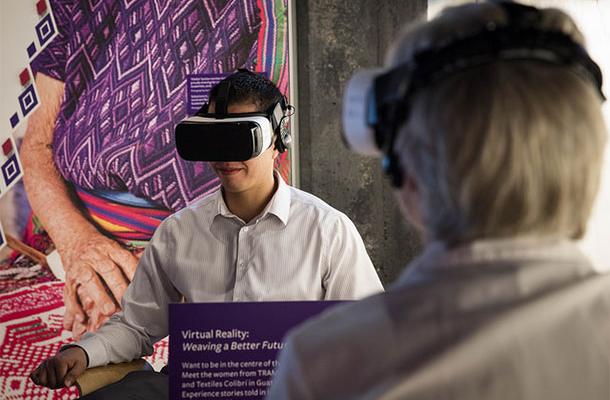Freedom of Expression in Latin America
In Latin America, art has often been used to express resistance in the face of repression and violence. Artistic expression can be used by those who refuse to stay silent when free speech is under attack. Art can also bear witness to atrocities committed by oppressive regimes.
Freedom of Expression in Latin America uses compelling works of art, powerful personal accounts, and augmented reality technology to tell the stories of people who have used art to expose truth and motivate action. The exhibit is located in the Museum’s introductory gallery (What Are Human Rights?).
Artists defy silence: The arpilleras

During Pinochet’s notorious dictatorship in Chile (1973-1990), groups of women known as arpilleristas created vivid patchwork pictures to condemn and depict the atrocities committed under the regime. The women worked at great risk to make these banned pieces of art. They smuggled their creations abroad as messages of resistance intended to encourage solidarity with the Chilean people.
One of the arpilleras shown in the exhibition is the story of Carmen Gloria Quintana, an 18-year-old student protestor who in 1986 was doused with gasoline by soldiers and set on fire. With the help of Canadian diplomat Christian Labelle, she was flown to Canada for treatment and her family was given refuge. When Labelle saw Quintana again in Ottawa in 2015, almost 30 years later, he gave her two other arpilleras which tell her story, made by a group of women in her neighbourhood in Chile. Quintana currently lives in Montreal.
Listen to the interview (in Spanish)
Read a CMHR curator interview with Carmen Gloria Quintana (translated to English).
Listen to the interview (in French)
Read a CMHR curator interview with Christian Labelle (translated to English).
A story in augmented reality
Augmented reality technology is used to further explore the story of Quintana being set on fire as a teenaged dissident in Chile, and taken for treatment and refuge in Canada. Visitors use an iPad to hover over the arpillera containing her story, which then reveals on-screen images and text about her experiences – including excerpts from CMHR curator interviews conducted in 2016. This feature also provides visitors with exclusive access to two digital artifacts (additional arpilleras) which are not physically present in gallery.
Experience the story anywhere!
Learn about Carmen Quintana and her journey to Canada as told through arpilleras. Download and print this PDF and download the free augmented reality app (called “Stitching Our Struggles: Resistance Through Art”) for iPhone or Android device to explore! Cards with the arpillera image are also available in gallery.
Artists bear witness: The retablos

Retablos are sophisticated forms of folk art comprised of portable boxes depicting events important to the Indigenous people of the highlands of Peru and Bolivia. Following a violent conflict between a political group called “The Shining Path” and the Peruvian government in the 1980s and 1990s, artists used retablos to help preserve survivor testimonies. A large stage in the form of a retablo was built for the release of Peru’s Truth and Reconciliation report in 2003.
Peruvian Indigenous artist Edilberto Jiménez Quispe has created replicas of two of his great works for the Canadian Museum for Human Rights. In one, the Chungui people ask a hummingbird to spread the word about human rights violations inflicted upon their people. In another retablo, called “Death,” the artist disguised the soldier figures as monks to avoid retaliation after the military broke into his house as he worked on this piece.
Artists call for action: Altars de Día de Muertos

In Mexico, altars to honour the dead pre-date European contact. They contain memorabilia of loved ones, colourful paper decorations, flowers, candles and brightly coloured skulls. Annual “Day of the Dead” (Día de Muertos) celebrations on November 2 originated with ancient traditions.
The Museum of Memory and Tolerance in Mexico City created a Day of the Dead altar as a call to action for protection of journalists’ lives and their right to freedom of expression. Mexico is one of the world’s most dangerous countries for journalists, who can be killed for reporting on drug cartels and state corruption. Thirty-seven journalists have been murdered in Mexico since 1992 because of their investigative work and 47 others have died under suspicious circumstances.

This exhibit includes personal belongings of Rubén Espinosa, a journalist critical of the government in Veracruz, who was tortured and killed in 2015.








